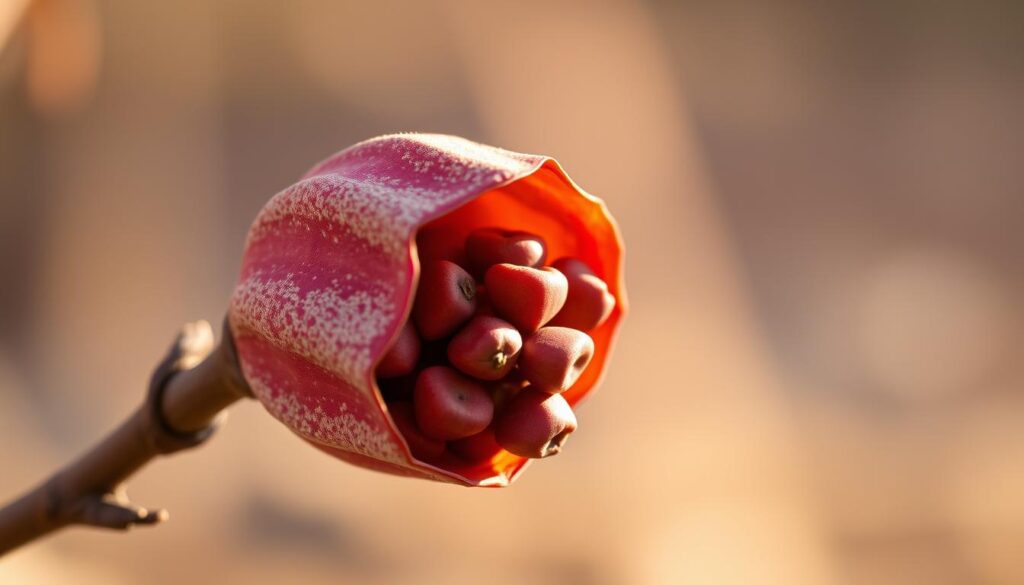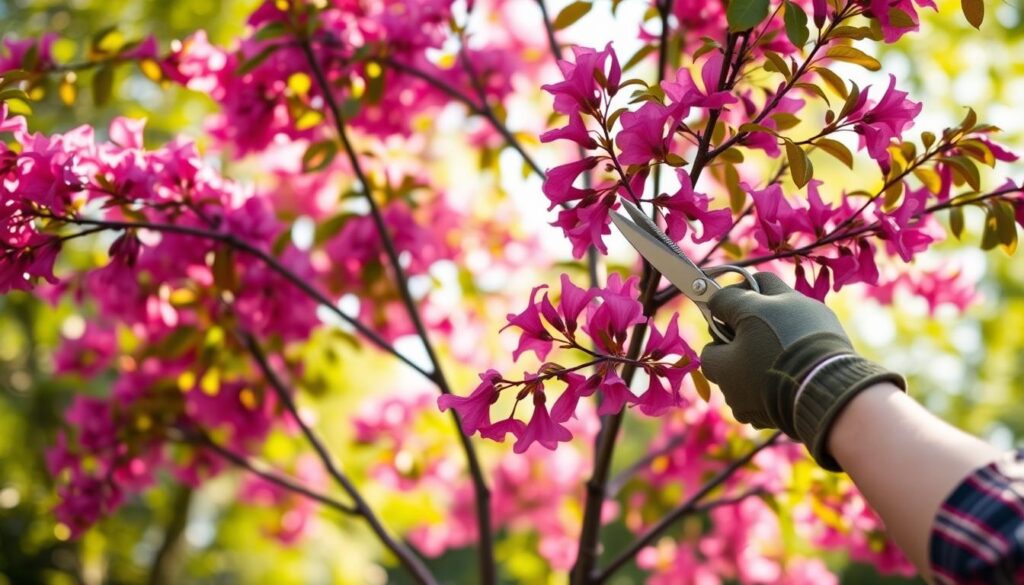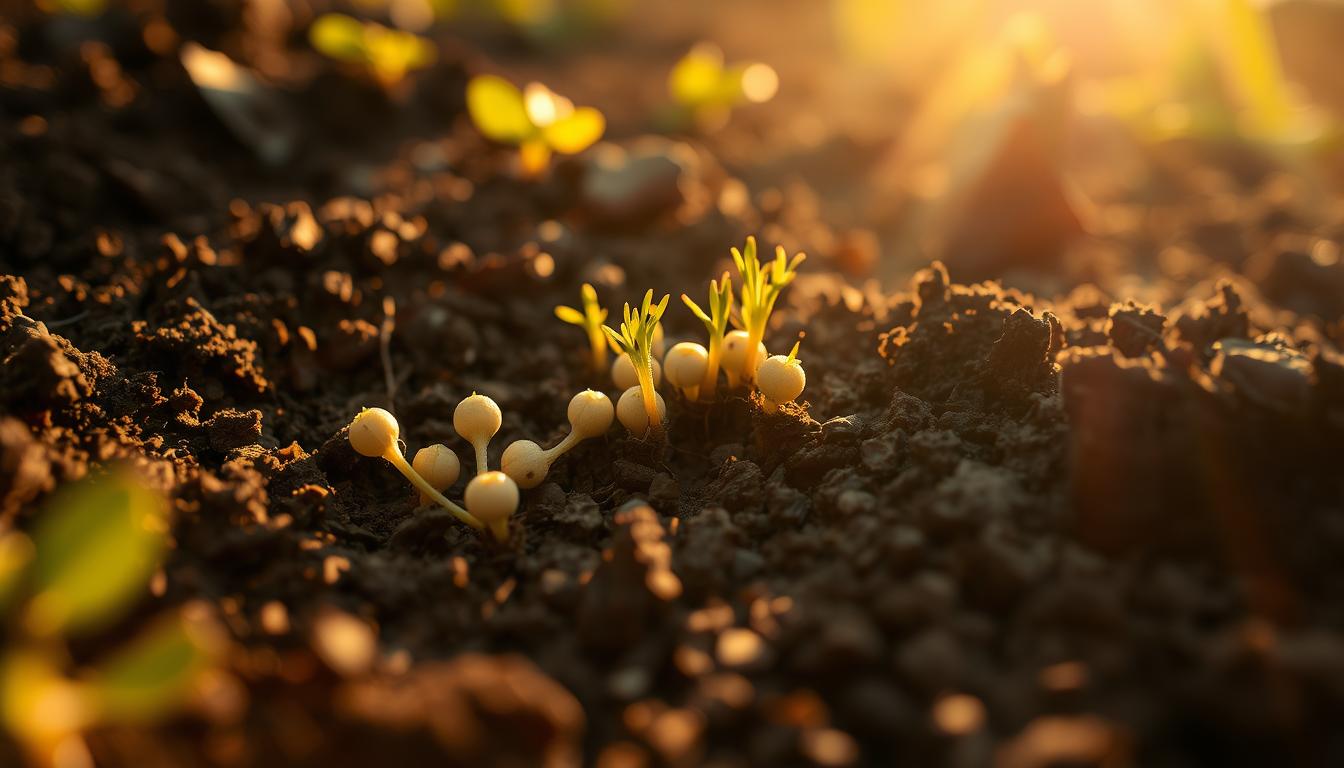Growing an eastern redbud can turn your yard into a colorful, lively space. I discovered Cercis canadensis years ago. A single seed sprouted in my backyard, bringing spring blossoms and beauty.
Redbud seeds let gardeners grow a native North American tree. This tree adds beauty and helps local ecosystems. This guide will help you grow and care for your redbud tree, whether you are new or experienced.
Table of Contents
Understanding the Eastern Redbud: A Native Beauty
The eastern redbud, known as Cercis canadensis, is a standout native plant. It wins the hearts of gardeners and nature lovers in North America. This tree is more than a pretty face; it’s vital for local ecosystems.
Native plants like the eastern redbud are key for local wildlife. Let’s look at what makes this tree unique:
Characteristics of Cercis canadensis
- Distinctive heart-shaped leaves that turn yellow in autumn
- Vibrant purple-pink flowers blooming early in spring
- Compact size, typically growing 20-30 feet tall
- Smooth, gray bark with a graceful branching structure
Natural Habitat and Growth Patterns
The eastern redbud does well in many places, from woodlands to open fields. It grows in various soils and light, making it great for many gardens.
| Growing Zones | Preferred Conditions |
|---|---|
| USDA Zones 4-9 | Partial shade to full sun |
| Soil Type | Well-drained, slightly acidic |
| Moisture Needs | Medium, tolerates occasional drought |
Benefits for Local Wildlife
Your eastern redbud does more than look good. It’s a big help for local wildlife:
- Provides essential nectar for early-season pollinators
- Offers food and shelter for various bird species
- Supports caterpillar populations, crucial for butterfly reproduction
- Creates safe habitat for small mammals
The eastern redbud is nature’s way of painting landscapes with ecological significance and breathtaking beauty.
Getting Started with Redbud Seeds
If you love gardening and want to grow eastern redbud trees, seed propagation is a great way to start. But it needs careful preparation to make sure the seeds grow well. This journey is both tough and very rewarding.
To grow redbud trees from seeds, you need to know a few things. Eastern redbud seeds have a hard shell that makes them hard to plant. You have to treat them right before you can plant them.
Seed Collection and Preparation
- Collect the seed pods in late summer when they turn brown and begin to dry
- Harvest pods before they split open to prevent seed loss
- Store collected pods in a cool, dry place
Seed Treatment Techniques
- Scarification: Break the hard seed coat by:
- Rubbing seeds with sandpaper
- Soaking seeds in warm water for several hours
- Boil seeds briefly for 1 minute
- Cold Stratification: Simulate winter conditions by:
- Store seeds in a moist medium at 33°F to 41°F
- Keep seeds refrigerated for 30-90 days
When it’s time to plant, use a mix that drains well, like sand and peat moss. Plant the seeds about an inch deep and keep the soil moist. Redbud seeds can grow in zones 4 to 9, so many gardeners can enjoy these trees.
| Seed Treatment | Method | Duration |
|---|---|---|
| Scarification | Sandpaper rubbing | 5-10 minutes |
| Soaking | Warm water immersion | 4-12 hours |
| Cold Stratification | Refrigeration | 30-90 days |
With patience and the right techniques, you can grow stunning redbud trees. They will make your garden even more beautiful.
Optimal Growing Conditions for Success
Creating the perfect environment for your redbud tree is crucial in horticulture. These stunning ornamental trees need specific conditions to thrive. Knowing the right growing requirements will help you nurture a healthy and vibrant redbud.
Soil Requirements and Preparation
Redbuds demand well-draining, fertile soil with a specific pH range. The ideal soil conditions include:
- Soil pH between 6.0 and 7.5
- Rich, organic soil composition
- Good drainage to prevent root rot
Before planting, prepare your soil by mixing in compost and ensuring proper drainage. This step supports robust root development for your ornamental trees.
Light and Temperature Needs
Redbud trees thrive in specific light and temperature conditions:
| Growing Condition | Ideal Range |
|---|---|
| Sunlight Exposure | Part sun to part shade |
| Soil Temperature | 65°F to 70°F (18°C to 21°C) |
| Hardiness Zones | 4 to 9 |
Watering Guidelines
Proper watering is essential for landscape plants like redbuds. Consistent moisture is key to successful growth:
- Water deeply and regularly
- Maintain consistently moist soil
- Avoid waterlogging
- Reduce watering during dormant seasons
By following these guidelines, you’ll create an optimal environment for your redbud tree to flourish in your garden.
Seasonal Care and Maintenance Tips
Caring for your flowering trees needs a year-round plan. Redbud trees need special care in each season for growth and blooms.
Spring is key for gardening success. After the last frost, do these important tasks:
- Apply a balanced fertilizer around the tree’s base
- Check for winter damage and prune damaged branches
- Mulch around the root zone to retain moisture
Summer care means watching your watering. Water deeply once a week, especially in dry times. Young trees need shade from strong sun.
Fall is for winter prep. Collect seeds for planting. Remove dead or sick branches to avoid winter harm.
Winter care is vital for young trees. Use tree wraps to protect from sun and wind. Stay away from chemicals near the roots.
- Wrap trunk with burlap or tree wrap
- Avoid salt and chemical exposure
- Minimize pruning during dormant season
Follow these seasonal tips to keep your redbud tree healthy and blooming beautifully every year.
Common Varieties and Their Unique Features
Cercis canadensis offers gardeners a stunning array of ornamental trees with remarkable diversity. Each variety brings its own distinctive charm to landscape plants. They transform outdoor spaces with vibrant colors and unique characteristics.
When selecting redbud varieties for your garden, consider these exceptional options. They can elevate your landscape design:
Forest Pansy Redbud
The Forest Pansy Redbud stands out with its rich purple-black foliage. This spectacular ornamental tree captures attention with its dramatic color transitions. Key features include:
- Deep glossy purple leaves
- Vibrant purple blooms
- Mature height of 20-30 feet
- Thrives in USDA Hardiness Zones 5-9
Hearts of Gold Redbud
For gardeners seeking extraordinary color, the Hearts of Gold Redbud delivers an impressive display. Its unique foliage creates a stunning visual impact in landscape plants:
- Striking gold leaves that mature to chartreuse
- Light lavender spring flowers
- Compact growth habit
- Performs well in USDA Hardiness Zones 5-9
Rising Sun Redbud
The Rising Sun Redbud is a true showstopper among Cercis canadensis varieties. Its kaleidoscope of colors provides year-round visual interest:
- Emerging leaves in apricot and gold
- Transitioning to lime green
- Delicate pink-purple blossoms
- Ideal for smaller garden spaces
Each of these remarkable redbud varieties offers something special. You can find the perfect ornamental tree to complement your landscape design.
Troubleshooting Growth Issues

Exploring horticulture with redbud trees can lead to growth challenges. These issues can affect your seed propagation efforts. Knowing these problems helps you develop successful gardening strategies.
Seed germination in redbud cultivation can be tricky. Some common problems include:
- Poor seed viability
- Inconsistent moisture levels
- Temperature fluctuations
- Fungal infections
Specific diseases can harm your redbud’s health. Watch for these warning signs:
- Botryosphaeria Canker: Look for splotchy leaves and dead branches
- Verticillium Wilt: Observe wilted, discolored foliage
- Vascular Streak Dieback: Check for leaf chlorosis and stunted growth
To overcome seed propagation challenges, implement these preventive techniques:
- Use scarification to break seed dormancy
- Maintain consistent soil moisture
- Protect seedlings from extreme temperatures
- Sterilize gardening tools between uses
By understanding these potential growth issues, you can create a robust approach to redbud cultivation. This approach minimizes risks and maximizes successful seed propagation.
Maximizing Blooming Potential
To make your landscape pop with flowering trees, you need a plan and some gardening know-how. Redbud trees are famous for their vibrant spring blooms. With the right steps, you can turn your outdoor area into a stunning sight.
Learning how to care for these beautiful trees is an art. It involves a few key strategies to boost their blooming power.
Timing Your Planting for Optimal Results
Getting your redbud tree off to a good start is all about timing. Keep these points in mind:
- The optimal soil temperature falls between 60°F and 70°F (15°C to 21°C).
- Aim for day lengths between 12 to 14 hours for healthy growth
- Regional variations matter – northern areas require later planting dates
- Consider local microclimates and elevation when planning
Fertilization Strategies for Vibrant Blooms
How you feed your tree is key to its blooms. Your fertilization plan can greatly impact its flowering:
- Use phosphorus-rich fertilizers in early spring
- Apply fertilizers directly around the root zone
- Consider foliar feeding for quicker nutrient absorption
- Avoid excessive nitrogen, which can reduce blooming potential
By focusing on the right plant for your area, you’ll have a thriving redbud. It’s all about knowing your local conditions and working with nature’s rhythms.
Pruning and Shaping Techniques

Pruning is key to keeping your redbud trees healthy and looking great. Knowing the right methods can turn these trees into beautiful garden highlights.
The best time to prune redbuds is in late winter or early spring. This is right before new growth starts. It helps the tree heal fast and reduces stress.
Essential Pruning Tools and Preparation
- Hand pruners
- Loppers
- Pruning saw
- Safety gear (gloves, goggles)
- Disinfectant alcohol
Before you start, clean your tools with denatured alcohol. This stops diseases from spreading. Remove:
- Dead or diseased branches
- Branches that block sunlight
- Crowded or crossing limbs
Pruning Techniques for Different Tree Ages
Young redbud trees need a strong structure. Pick a central leader and promote even branch spacing. Mature trees need regular pruning to stay healthy and shaped.
| Pruning Method | Purpose | Technique |
|---|---|---|
| Thinning | Improve light and air circulation | Remove select branches |
| Heading | Control size and encourage growth | Cut to lateral branch or bud |
| Shearing | Create uniform shape | Trim outer foliage sparingly |
Always make clean cuts above a healthy bud or branch. Don’t leave stubs, as they can decay and attract pests.
Disease Prevention and Treatment
To keep your redbud trees healthy, you need to be proactive. Understanding the health challenges of native plants is key. Recognize threats early and use prevention strategies.
Common Pests and Problems
Redbud trees face many health issues:
- Vascular Streak Dieback (VSD) caused by Ceratobasidium fungus
- Fungal infections like Cercospora and Anthracnose
- Bacterial leaf scorch
- Environmental stress factors
Natural Remedies and Solutions
Managing redbud tree health requires several steps:
- Use preventative fungicide applications
- Maintain proper irrigation practices
- Select healthy propagation materials
- Minimize unnecessary pruning
For severe infections, try these fungicides:
| Fungicide | Active Ingredients | Application Frequency |
|---|---|---|
| Postiva | Pydiflumetofen + Difenoconazole | Every 14 days |
| Mural | Azoxystrobin + Benzovindiflupyr | Every 14 days |
New research aims to create more resistant redbud trees. This could lead to healthier trees in your garden.
Conclusion
Growing redbud seeds is a rewarding journey that connects you to nature. By learning about the Eastern redbud, you can add beauty to your outdoor spaces. You also help local wildlife by supporting biodiversity.
Planting redbud seeds does more than make your garden look good. These trees are crucial for birds, mammals, and insects. They provide food and shelter, helping to conserve wildlife.
Begin your redbud adventure with hope. Each seed can grow into a stunning tree. With the right knowledge, you can grow these amazing plants. Watch as your garden changes for the better.
Be patient and take good care of your redbud seeds. Your hard work will pay off with beautiful flowers and green leaves. You’ll also be helping a native species thrive in your area.
FAQ
How long does germination take for redbud seeds?
Redbud seeds usually sprout in 7-21 days under the right conditions. First, you need to stratify the seeds. This means keeping them cold and moist for 60-90 days. This step helps break their dormancy and boosts germination.
What’s the ideal time to gather redbud seeds?
The best time to pick redbud seeds is from late summer to early fall. This is usually between August and October. Look for seed pods that are brown and drying out. Collect them before they open for the best quality seeds.
Can I grow a redbud tree in a container?
Yes, you can grow a redbud tree in a container, especially when it’s young. Use a large pot with good drainage and well-draining potting soil. Be ready to move the tree to the ground as it grows. Container-grown redbuds need more water and sometimes need their roots pruned.
What type of soil do redbud trees prefer?
Redbud trees do well in well-draining, slightly acidic soil with a pH of 6.5 to 7.5. They like loamy soil with lots of organic matter but can adapt to different soils. Make sure the soil drains well to prevent root rot and help the tree grow.
How often should I water my young redbud tree?
Young redbud trees need consistent moisture, but avoid overwatering. Water deeply once or twice a week, based on your climate and soil. In the first year, give it 1-2 inches of water per week. Then, water less as the tree grows.
Are redbud trees native to North America?
Yes, the Eastern Redbud is native to the eastern United States. It’s common in woodlands from southern Ontario to Florida and as far west as Texas.
What are the most common pests that affect redbud trees?
Redbud trees can face pests like Japanese beetles, scale insects, spider mites, and borers. Regular checks, proper care, and keeping the tree healthy can help prevent and manage these pests.
How can I encourage more blooms on my redbud tree?
For more blooms, make sure your redbud gets enough sunlight (partial shade to full sun). Avoid too much nitrogen fertilizer and prune lightly. A balanced fertilizer in early spring and good soil can help your tree bloom more.
Can redbud trees grow in cold climates?
The Eastern Redbud can handle temperatures as low as -20°F, making it hardy in USDA zones 4-9. While it can survive cold, protecting it in winter and choosing the right planting spot can help it thrive.

